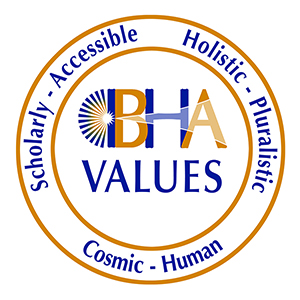
| Primary Big History Course | Teaching Big History | Big Architecture |
Primary Level Big History Course
The IBHA is pleased to share a new free online Big History teaching program designed especially for the use of primaryschool teachers and their students (https://www.coolaustralia.org/big-history-education-resources/).
The primary schools program is supported by an online teacher professional development course. Although both the program and the PD course have been mapped to the Australian curriculum, it provides an inspiring model for those in other countries as well (https://learn.coolaustralia.org/course/big-history-cc058/).
The courses are located on the Cool Australia online educational website (https://www.coolaustralia.org/) which focuses on sustainable education initiatives. Cool Australia has been very supportive in the development of these online programs. The site has approximately 144,000 educator members, who can freely access the teaching materials.
1. The primary-based, online Big History learning Program
The program is adapted from the secondary-based Big History Project (https://www.oerproject.com/Big-History). The primary-based Big History course empowers students to apply critical inquiry-based learning as they investigate the crucial roles that past, present and future play towards a sustainable, wider worldview, rather than fragmented silos of learning about our universe. It highlights the important role of literacy through literature as factual storytelling, and is structured for primary teachers to be lead learners alongside their students as co-learners. The program provides a transdisciplinary approach, including through the lens of literacy and the value of storytelling in the universe story. The 10 online units and their lessons provide learning scaffolds, using a range of videos, student-friendly website links, activities and resources for students to investigate the history of the universe, from the Big Bang through to the formation of the galaxy and our earth, life on earth and future possibilities. Learning about 13.82 billion years of Big History helps primary students to understand the changing nature and fragility of our complex environment. We can use knowledge of the past, present and future to investigate future possibilities for sustainable ways to meet our own needs and the needs of future generations.The Big History Program for primary school students is based on the Big History Project as adapted by IBHA member Marilyn Ahearn and Marisa Colonna.
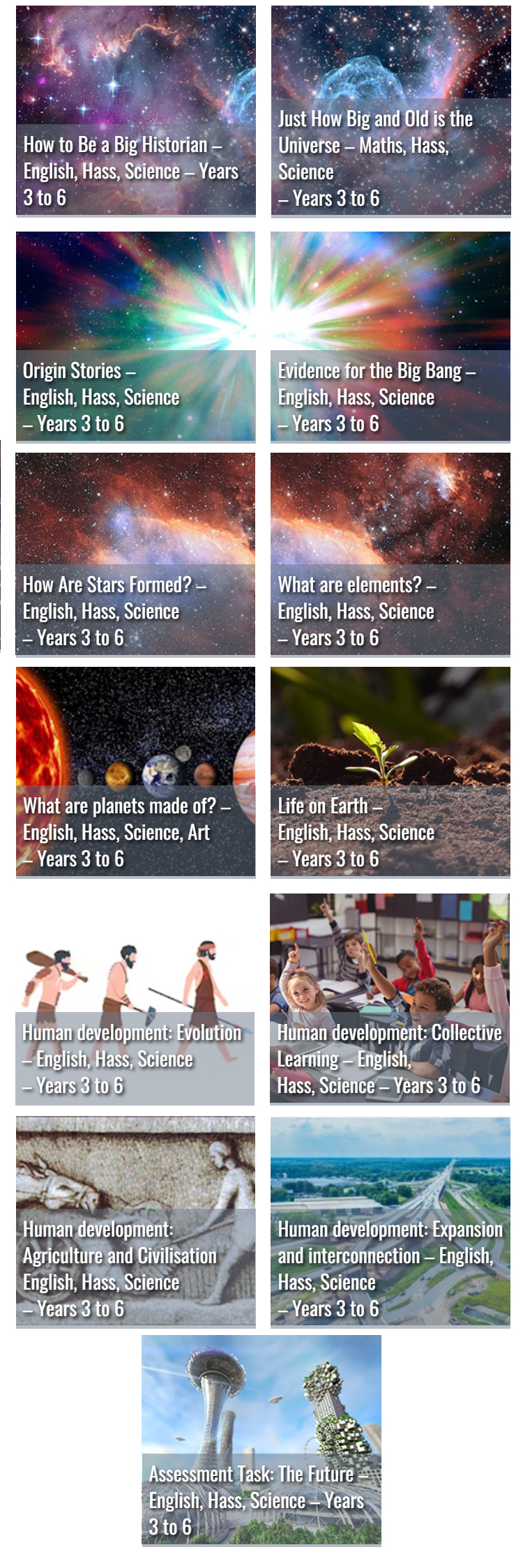
2. The accompanying teacher online Big History Professional Development course
This course is written for teachers from Marilyn Ahearn’s PhD research findings on the extent the scientific universe story, as told through Big History, influenced primary students’ understanding towards a wider worldview of sustainability.
The accompanying teacher online Professional Development course supports teachers who wish to understand:
- ‘why’ teach an emerging scientific universe story through the vehicle of a Big History program
- ‘how’ to use a transdisciplinary approach to teaching Big History
- ‘what’ to teach in Big History to empower primary students towards investigating future sustainable possibilities for our planet.
The course addresses:
- How to incorporate a transdisciplinary Big History learning approach, interrelating Sustainability learning and STEAM inquiry within a critical-inquiry - based learning curriculum.
- How to interconnect a changing, cohesive (his)story of our universe with socioecological learning that considers environmental, economic, societal and welfare needs of communities
- How Big History incorporates transdisciplinary learning, inclusive of STEAM inquiry, to empower student curiosity about the history of the universe and potential impacts on the environment
- How to structure a gradual release of responsibility across a unit, from teacher as instructor to teacher as lead-learner, who guides students as co-learners, in independent evidence-based questioning and learning
- How to guide students to self-assess alongside teacher assessments within the above learning structure.
This four-hour PD course is for busy teachers to investigate at their own pace and suitable times. It is accredited by most state education jurisdictions in Australia which attests to its educational validity.
 The course is taught by Marilyn Ahearn, IBHA member and an adjunct lecturer at Southern Cross University, Gold Coast. She labels herself as firstly a primary school teacher promoting sustainability and only decided to embark on her PhD research when she stumbled across primary students’ excitement in learning Big History. Sadly, while it enthused students, the wider education community saw it merely as an add-on! How to spread the message? Embark on a PhD and continue cycling to keep her sanity! Jump to the present and Marilyn continues to champion a Big History learning framework for primary education as she also begins to turn her thesis into published articles.
The course is taught by Marilyn Ahearn, IBHA member and an adjunct lecturer at Southern Cross University, Gold Coast. She labels herself as firstly a primary school teacher promoting sustainability and only decided to embark on her PhD research when she stumbled across primary students’ excitement in learning Big History. Sadly, while it enthused students, the wider education community saw it merely as an add-on! How to spread the message? Embark on a PhD and continue cycling to keep her sanity! Jump to the present and Marilyn continues to champion a Big History learning framework for primary education as she also begins to turn her thesis into published articles.
This course is told from Marilyn’s perspective, backed up by her extensive classroom experience and her completed PhD research in Big History in a primary classroom setting.
 Marisa Colonna first encountered Big History when she was undertaking a BA DipEd at Macquarie University, Sydney. She discovered a class from the ‘father’ of Big History, Professor David Christian, and her way of thinking about the Universe and everything in it was forever altered. She was fortunate to have the opportunity to help develop a Big History program for primary school students which she has been teaching now for 5 years. Teaching Big History, and seeing the wonder and awe it engenders in her students, has been the highlight of her teaching career.
Marisa Colonna first encountered Big History when she was undertaking a BA DipEd at Macquarie University, Sydney. She discovered a class from the ‘father’ of Big History, Professor David Christian, and her way of thinking about the Universe and everything in it was forever altered. She was fortunate to have the opportunity to help develop a Big History program for primary school students which she has been teaching now for 5 years. Teaching Big History, and seeing the wonder and awe it engenders in her students, has been the highlight of her teaching career.
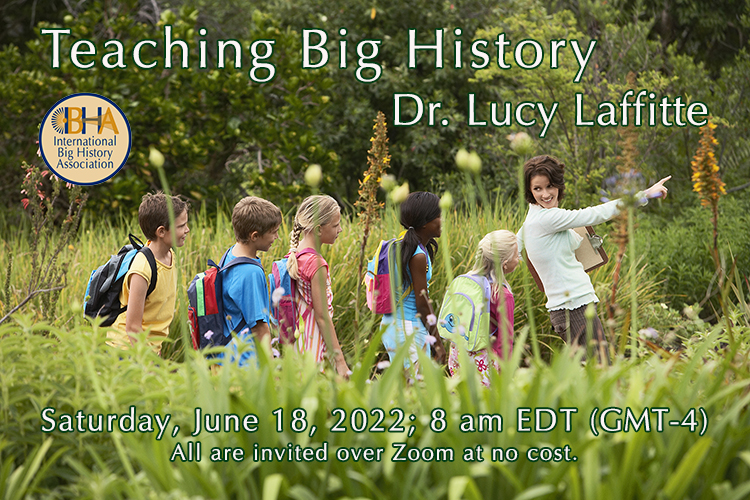
Please mark down the June 18 webinar by Dr. Lucy Laffitte on teaching big history. She earned her Ph.D. in forestry and natural resources and has been teaching big history to college freshmen and middle school students since 2012. She has served the IBHA as an active member, conference program committee chair, founding editor of Emergence (IBHA newsletter), board member, vice-president, and president.
As she has learned, middle school is an awkward time for everyone, teachers and students alike. The math curriculum is a drop into the deep end of the algebra pool where those who know their math facts can swim to safety but those that don’t thrash around painfully. There are no content standards for language arts or social studies—just deepening reading and writing skills and the Next Generation Science Curriculum is an incoherent jumble of physics, earth science, and biology. First-year college students stand on the shore of their small islands of knowledge with no maps for their voyage ahead. Why not take this unorganized cornucopia of content and replace it with the grand narrative of the unfolding universe? This presentation describes such a curriculum and shares anecdotal results of a pilot project.
International-Big History-Association is inviting you to a scheduled Zoom meeting with Lucy Laffitte as she discusses “Teaching Big History” on Saturday, June 18, 2022, at 8 am EDT (GMT-4:00).
Join Zoom Meeting
https://us06web.zoom.us/j/87612385987?pwd=U2ZucGpRSHJ6U1hiWmEyTXlYTklLZz09
| Members of the IBHA are committed to the widest possible availability of this presentation; it is open at no cost to all over Zoom. To support the programing of the IBHA and participate in our association, please consider joining and in making a donation. |
Meeting ID: 876 1238 5987
Passcode: 839234
One tap mobile
+19292056099,,87612385987#,,,,*839234# US (New York)
+13017158592,,87612385987#,,,,*839234# US (Washington DC)
Dial by your location
+1 929 205 6099 US (New York)
+1 301 715 8592 US (Washington DC)
+1 312 626 6799 US (Chicago)
+1 669 900 6833 US (San Jose)
+1 253 215 8782 US (Tacoma)
+1 346 248 7799 US (Houston)
Meeting ID: 876 1238 5987
Passcode: 839234
Find your local number: https://us06web.zoom.us/u/khJgtN1sp
Please click here for event flyer. |
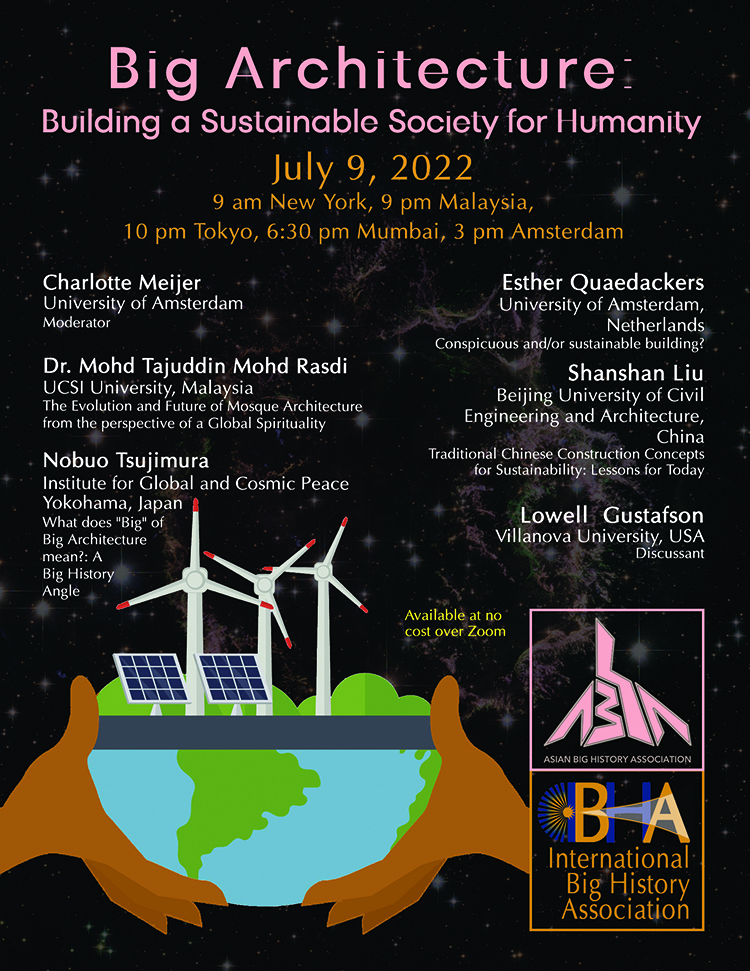
Panel
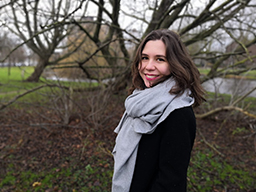 Charlotte Meijer
Charlotte MeijerUniversity of Amsterdam
Moderator
Charlotte Meijer is a graduate student at the University of Amsterdam’s faculty of humanities, specializing in the early modern period with a focus on the history of knowledge and human-animal relations. She has been involved in the organization of various big history courses at the UvA for the past six years. Through the Big History Project she also supports Dutch teachers who teach big history at the high school level.
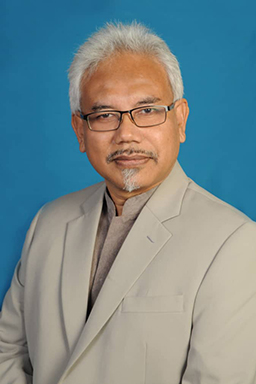 Dr. Mohd Tajuddin Mohd Rasdi
Dr. Mohd Tajuddin Mohd RasdiUCSI University, Malaysia
The Evolution and Future of Mosque Architecture from the perspective of a Global Spirituality
The architecture of the mosque is directly tied to the perspective and narrative of Islam in the modern world. The main intention of this talk is to present the mosque as a progressive and an inclusive architecture that can contribute both to nation building and global spiritual consciousness.
The present socio-political narrative of Islam in Malaysia and many parts of the Muslim worlds is governed by a narrow minded religious institution, an opportunist political leadership and an ignorant middle class of Muslims on both the subject matter of Islam as well as the need for a global inclusiveness in social, political, environmental and educational concerns. This talk will unravel the progressive aspect of Islam and the mosque from its early beginnings and trace its role and development through the historical, political and architectural frameworks through out the ages and in Malaysia in particular.
In Islam, the mosque was never a specifically defined building as prayers can be performed anywhere that is clean and its evolution in the post prophetic era was more a political and social development rather than religious. After that the mosque was more a military fort or garrison for the Muslim army and later on became a shelter for Muslim worship and politics in its empire era. In the 19th and 20th century of the modern state, Islam became a cultural element in social concerns and the mosque became a symbol of religion and religious activities.
During the 1970s, the Islamic Reformation Movement took many Muslim nations into an era of social and political change where the mosque was the center of community for Muslims. In the 21st century, the Islamic Reformation was hijacked by conservative and extremist elements as attested from the bombings and killings by the Islamic State Terrorists and the mosque reverted into a monumental symbol of state sponsored Islam without much liberty in thought, and social expressions. The discourse of mosque architecture is now frozen into a dogmatic and doctrinal Islam which has left the mosque into a stylistic construct of sustainability discussions as well as an historical adaptation of forms and artistic expression.
Finally, I will present the new directions of mosque as an element of inclusive nation building, as a centre for universal humanitarian aid and as an expression of architectural liberalism of technology, history and universal spirituality of form and functions. This talk is important to free Islam and the mosque into a global presence of spiritual growth and community building crossing the boundaries of faith, culture, technology and function.
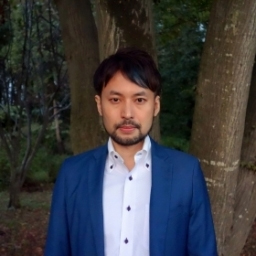 Nobuo Tsujimura
Nobuo TsujimuraInstitute for Global and Cosmic Peace
Yokohama, Japan
What does "Big" of Big Architecture mean?: A Big History Angle
The title of this webinar is Big Architecture. It shows our aim to rethink architecture in the light of big history. But what does "big" mean here? Big history sees everything beyond humans and Earth. So here the presenter focuses on nonhuman and space architectures and then tries to find hints for sustainability from them. We may be required to give a chance to fundamentally rethink and shed a new light on a fundamental question: why humans and other animals build something for living on earth.
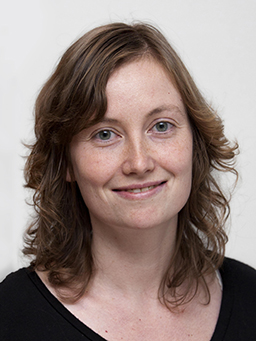 Esther Quaedackers
Esther Quaedackers University of Amsterdam, Netherlands
Conspicuous and/or sustainable building?
Humans are remarkable builders. Many of their buildings are special, but, perhaps surprisingly, not because humans use a lot of construction techniques that no other animal uses, or because they build much larger or more artistic structures than any other animal does. Human building is exceptional because in many situations, people combine building strategies that no other animal combines. They build in order to protect and organize their colonies, while using as little energy and materials as possible, like eusocial animals do. At the same time, they spend a lot of resources on aspects of building that help them to stand out from other members of their species, like artistic creatures such as bowerbirds do.
How did humans manage to combine these strategies, that are in a way at odds with each other, throughout their history?
This question is not just relevant for architectural history, but also for the future of building in a world characterized by dwindling resources. In such a world, it is useful to understand how our inclination to spend a lot of resources on certain aspects of building developed. It is even more useful to understand how that inclination developed in relation to ways to build while using as little energy and materials as possible. After all, such an understanding might help us develop less resource consuming and more sustainable building practices.
In order to address this question, the development of architectural traditions in both the eastern and western worlds will be explored. The differences and similarities between these traditions will contain lessons that are important for the future of sustainable building.
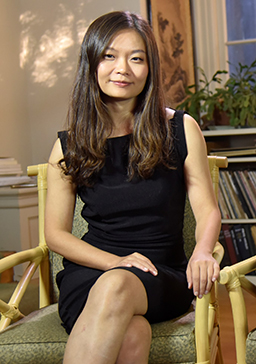 Shanshan Liu
Shanshan Liu
Beijing University of Civil Engineering and Architecture, China
Traditional Chinese Construction Concepts for Sustainability:
Lessons for Today
Ideological concepts play an important role in sustainable developments in a society. An influential ideology with ecological insights are likely to contribute to building a sustainable city and society. On the contrary, a social climate which lacks ecological concern may have devastating consequences for the society.
Chinese civilization has drawn lessons from a very long historical evolution. It can be observed that the civilization center shifted several times in Chinese primitive society; and each time the shifts followed an environmental collapse at the former site. This talk will discuss the ideological concepts on architecture, landscape and urban design in traditional Chinese society profoundly derived from the ecological and culture backgrounds of its origin.
Chinese ideology pursues the harmony between humankind and nature. The ideals of modesty and humbleness were essential elements in sustaining the society in China. The concepts' impact on architectural and urban design in China include restriction of large-scale constructions, depressing development of high-rise buildings and so on. These concepts acted as a safety valve to avoid extreme environmental and social collapse. And Chinese also strove to achieve a poetic dwelling integrated into the nature by garden design.
This talk will analyze the ecological background of the formation and development of Chinese concepts and examine how these values influenced architecture, landscape and urban design in different periods of Chinese history. It attempts to discuss the ecological insights behind these Chinese design concepts and their ideological and cultural significance for the development strategy of building healthy and sustainable cities and society today.
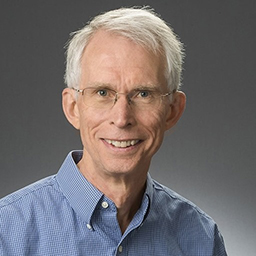 Lowell Gustafson
Lowell GustafsonVillanova University, USA
Discussant
Following Lowell's comments about the presentations, Charlotte will welcome questions and brief comments from everyone in attendance.
You are invited to a scheduled Zoom meeting.
Topic: Big Architecture: Building a Sustainable Society for Humanity
Time: Jul 9, 2022 09:00 Eastern Time (US and Canada; GMT-4)
Join Zoom Meeting
https://us06web.zoom.us/j/89984343354?pwd=VGVXR1FNNnI5ck5sVForbUpFWnMvZz09
| Members of the IBHA are committed to the widest possible availability of this presentation; it is open at no cost to all over Zoom. To support the programing of the IBHA and participate in our association, please consider joining and making a donation. |

What is consciousness and what is its role in the large scale evolutionary history of the universe that we call Big History? Is it possible to unify all of Big History into one unified coherent science: Macrocosmic Quantum Theory where consciousness is fundamental?
In this webinar Carl Calleman, a doctor of physical biology from the University of Stockholm, will argue that if we shift our perspective to be based on the evolution of consciousness, Big History can become a powerful discipline that will contribute significant results to our understanding of the universe and the “big” questions of what its purpose may be.
Basing himself on rarely discussed aspects of Mayan cosmological calendars verified by empirical studies, he then exemplifies the power of a unified Big History by proposing solutions to two prominent problems in current science:
- a/ What is the origin of life (How did the first cells emerge?) and
- b/ How can it be that the constants of nature are fine-tumed for the generation of life?
You are warmly invited to a webinar on the Consciousness.
July 16, 2022, 12 pm ED
International-Big History-Association is inviting you to a scheduled Zoom meeting.
Topic: Consciousness
Time: July 16, 2022 12:00 Eastern Time (US and Canada)
Join Zoom Meeting
https://us06web.zoom.us/j/83888125064?pwd=WUU2K1NpZzJ4NFZ3Z0w5Sjc1Rnp3Zz09
